Understanding and mastering scales is fundamental to becoming a proficient guitarist. Scales are the building blocks of melodies, solos, and improvisations. This guide will take you through an in-depth exploration of three essential scales: Major, Minor, and Pentatonic. We’ll discuss their theory, patterns, and practical applications.


1. What Are Scales?
Scales are sequences of notes arranged in ascending or descending order, each with a specific interval pattern. They serve as the foundation for creating melodies, harmonies, and solos. Scales help musicians understand the structure of music and provide a framework for improvisation and composition.
2. The Major Scale
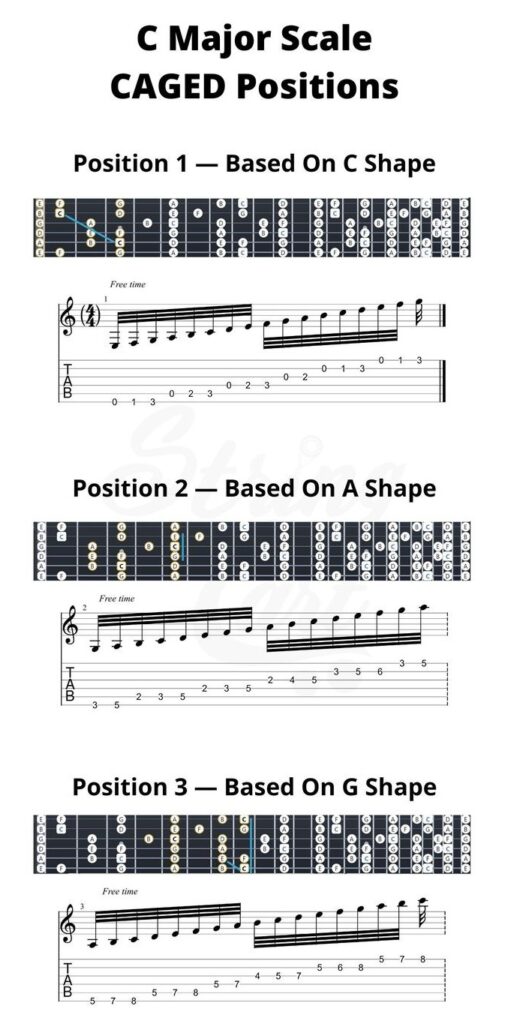

Theory:
- The Major scale is a diatonic scale consisting of seven notes, following a specific pattern of whole steps (W) and half steps (H): W-W-H-W-W-W-H.
- This pattern gives the Major scale its bright, happy sound.
Example: C Major Scale:
C D E F G A B C
W W H W W W HPattern on the Guitar:
- The C Major scale across two octaves:
e|-----------------------------|----------------3-5-7-|
B|-----------------------------|-----------3-5-7------|
G|-------------------------2-4-|-----2-4-5------------|
D|------------------2-3-5------|-3-5------------------|
A|-----------2-3-5-------------|----------------------|
E|--3-5-7----------------------|----------------------|Applications:
- Chords: Chords built from the Major scale are called diatonic chords. In C Major, the chords are C, Dm, Em, F, G, Am, Bdim.
- Melodies and Solos: The Major scale is often used in melodies and solos in pop, rock, country, and classical music.
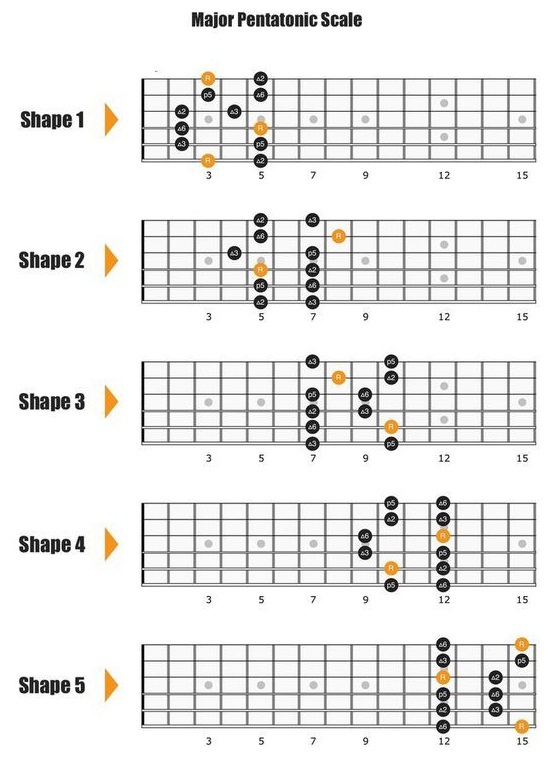

3. The Minor Scale
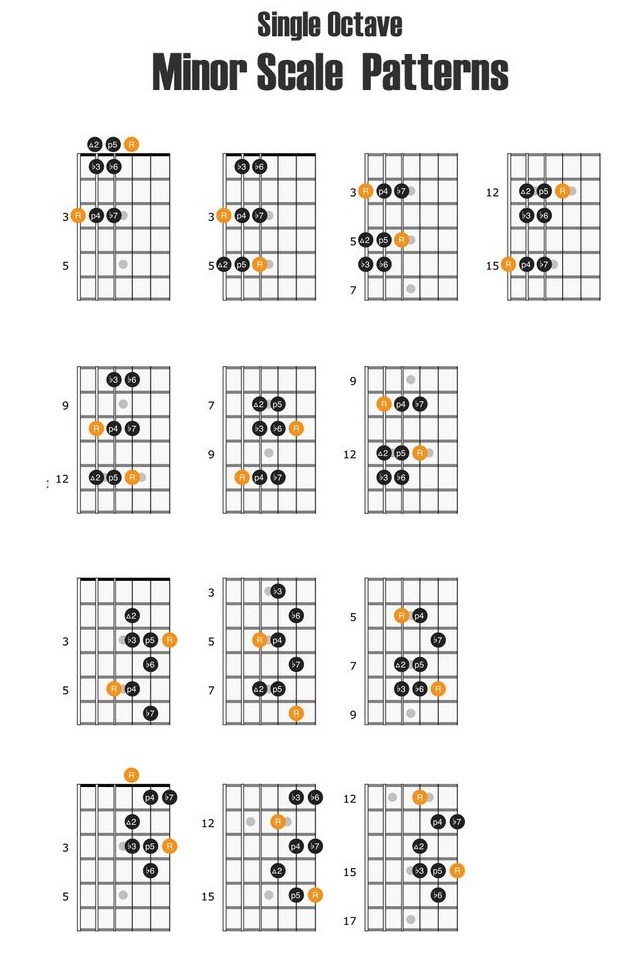

Theory:
- The Natural Minor scale is also a diatonic scale, consisting of seven notes with the pattern: W-H-W-W-H-W-W.
- This pattern gives the Minor scale its dark, melancholic sound.
Example: A Minor Scale:
A B C D E F G A
W H W W H W WPattern on the Guitar:
- The A Minor scale across two octaves:
e|-----------------------------|----------------5-7-8-|
B|-----------------------------|-----------5-6-8------|
G|-------------------------4-5-|-----4-5-7------------|
D|------------------5-7--------|-5-7------------------|
A|-----------5-7-8-------------|----------------------|
E|--5-7-8----------------------|----------------------|Applications:
- Chords: Chords built from the Minor scale are also diatonic. In A Minor, the chords are Am, Bdim, C, Dm, Em, F, G.
- Melodies and Solos: The Minor scale is used extensively in genres like blues, rock, metal, and classical music for its expressive, emotional quality.
4. The Pentatonic Scale
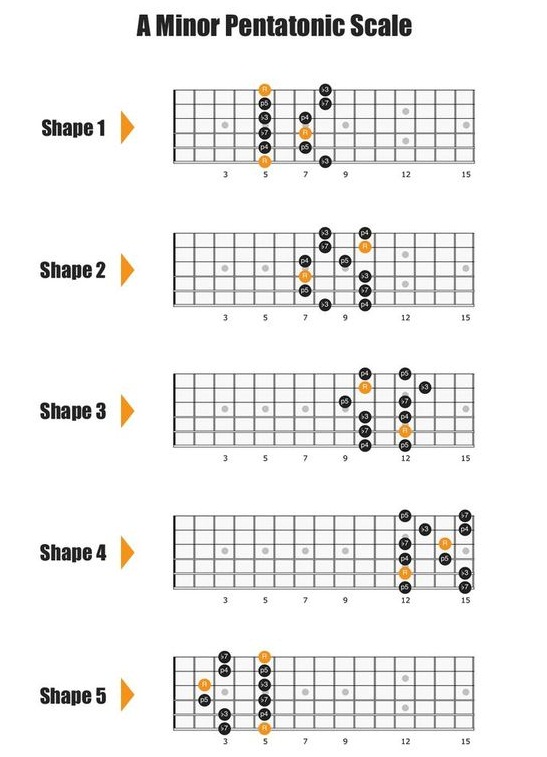

Theory:
- The Pentatonic scale is a simplified, five-note scale that removes the more dissonant intervals from the Major or Minor scale.
- There are two main types: Major Pentatonic and Minor Pentatonic.
Major Pentatonic:
- Pattern: W-W-m3-W-m3 (where m3 is a minor third interval)
- Example: C Major Pentatonic (C, D, E, G, A)
C D E G AMinor Pentatonic:
- Pattern: m3-W-W-m3-W
- Example: A Minor Pentatonic (A, C, D, E, G)
A C D E GPatterns on the Guitar:
C Major Pentatonic:
e|-----------------------------|-----------------5-7-|
B|-----------------------------|------------5-8------|
G|-------------------------4-5-|------4-5-7----------|
D|-------------------5-7-------|-5-7-----------------|
A|----------5-7-8--------------|---------------------|
E|--5-7-8----------------------|---------------------|A Minor Pentatonic:
e|-----------------------------|----------------5-8-|
B|-----------------------------|-----------5-8------|
G|-------------------------5-7-|-----5-7------------|
D|-------------------5-7-------|-5-7----------------|
A|-----------5-7-8-------------|--------------------|
E|--5-8------------------------|--------------------|Applications:
- Blues and Rock: The Minor Pentatonic is a staple in blues and rock guitar solos due to its simplicity and soulful sound.
- Country and Folk: The Major Pentatonic is often used in country and folk music for its bright and uplifting quality.
5. Practical Tips for Practicing Scales
Learn the Patterns:
- Memorize Shapes: Memorize the scale shapes and patterns on the fretboard. Start with one position and gradually expand to cover the entire neck.
- Connect Shapes: Practice connecting different scale shapes to play fluidly across the neck.
Use a Metronome:
- Consistency: Practice scales with a metronome to develop timing and consistency.
- Gradual Increase: Start at a slow tempo and gradually increase the speed as you become more comfortable.
Improvise:
- Create Melodies: Use scales to create your own melodies and solos. This helps internalize the sound and feel of each scale.
- Backing Tracks: Practice improvising over backing tracks in different keys and styles.
Visualize Intervals:
- Understand Intervals: Visualize and understand the intervals within each scale. This helps in building chords and creating melodies.
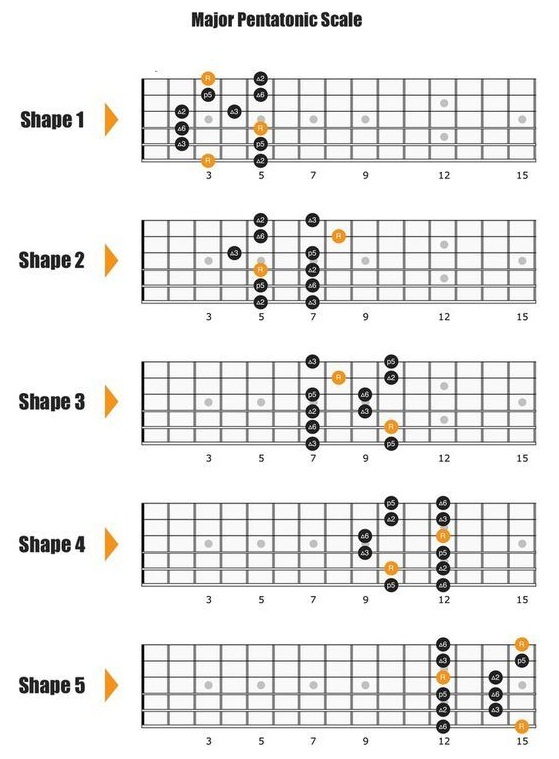

Conclusion
Mastering scales is essential for any guitarist. The Major, Minor, and Pentatonic scales form the foundation of many musical styles and provide the tools for creating melodies, solos, and harmonies. By understanding the theory behind these scales, memorizing their patterns, and applying them in your playing, you’ll enhance your musicality and versatility as a guitarist. Happy practicing!
- Unlocking Style Core Aesthetics: The New Era of Personal Fashion
- How to Knit for Beginners: Your Easy Step-by-Step Guide
- Bow and Arrow Basics: Everything You Need to Know
- Master the Bow: A Beginner’s Guide to Archery
- From Awareness to Action: Mastering the Art of Self-Defense

